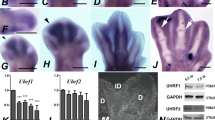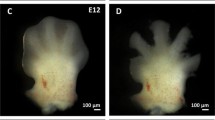Abstract
Syndactyly, a failure of the digits to separate into individual units, affects about 8 to 9 per 1000 newborns and results from an aberration of the normal development of the interdigital tissues. Limb digit separation is the result of programmed cell death (apoptosis). Lysosomes play a role in the process of cell self-destruction. Our experiment was designed to test the hypothesis that the intensity of interdigital lysosomes increases during the separation of digits in vivo and in vitro. The primary mouse monoclonal antibody, 1D4B, detects the presence of lysosomes by identifying the LAMP-I glycoprotein on the lysosome cell membrane. In our experiment this antibody immunodetected interdigital lysosome proteins in serial sections of limbs from Swiss-Webster mouse embryos, gestational ages E12.5 through E15, key developmental stages for digit separation. Digit separation was associated with an increase in intensity of lysosomal protein staining. In E12.5 limbs, the presence of lysosomes was enriched in the distal aspect of the interdigital tissue. However, the number of lysosomes markedly increased in the E13 and E14 limbs, including the entire length and width of the interdigital tissue in the E14 limbs. This lysosomal protein presence in E14 limbs was significant compared to E12.5, E13, and E15 limbs. By day 12.5, the mouse embryo limb is committed to digit separation. Addition of retinoic acid to the culture medium of limbs earlier in development, such as E12, results in induction of the process of digit separation. Cultured E12 limbs that did not receive an addition of retinoic acid, did not show digit separation. We conclude that in the limb development process, the enrichment in interdigit LAMP-1 proteins, may indicate a relationship between lysosomes, apoptosis, and digit separation. We also conclude that retinoic acid has an important role in digit separation in vivo, as shown in limb development, and demonstrated through the addition of retinoic acid to media of cultured tissues.
Similar content being viewed by others
Author information
Authors and Affiliations
Additional information
Accepted: 17 January 2000
Rights and permissions
About this article
Cite this article
Stewart, S., Yi, S., Kassabian, G. et al. Changes in expression of the lysosomal membrane glycoprotein, LAMP-1 in interdigital regions during embryonic mouse limb development, in vivo and in vitro. Anat Embryol 201, 483–490 (2000). https://doi.org/10.1007/s004290050335
Issue Date:
DOI: https://doi.org/10.1007/s004290050335




